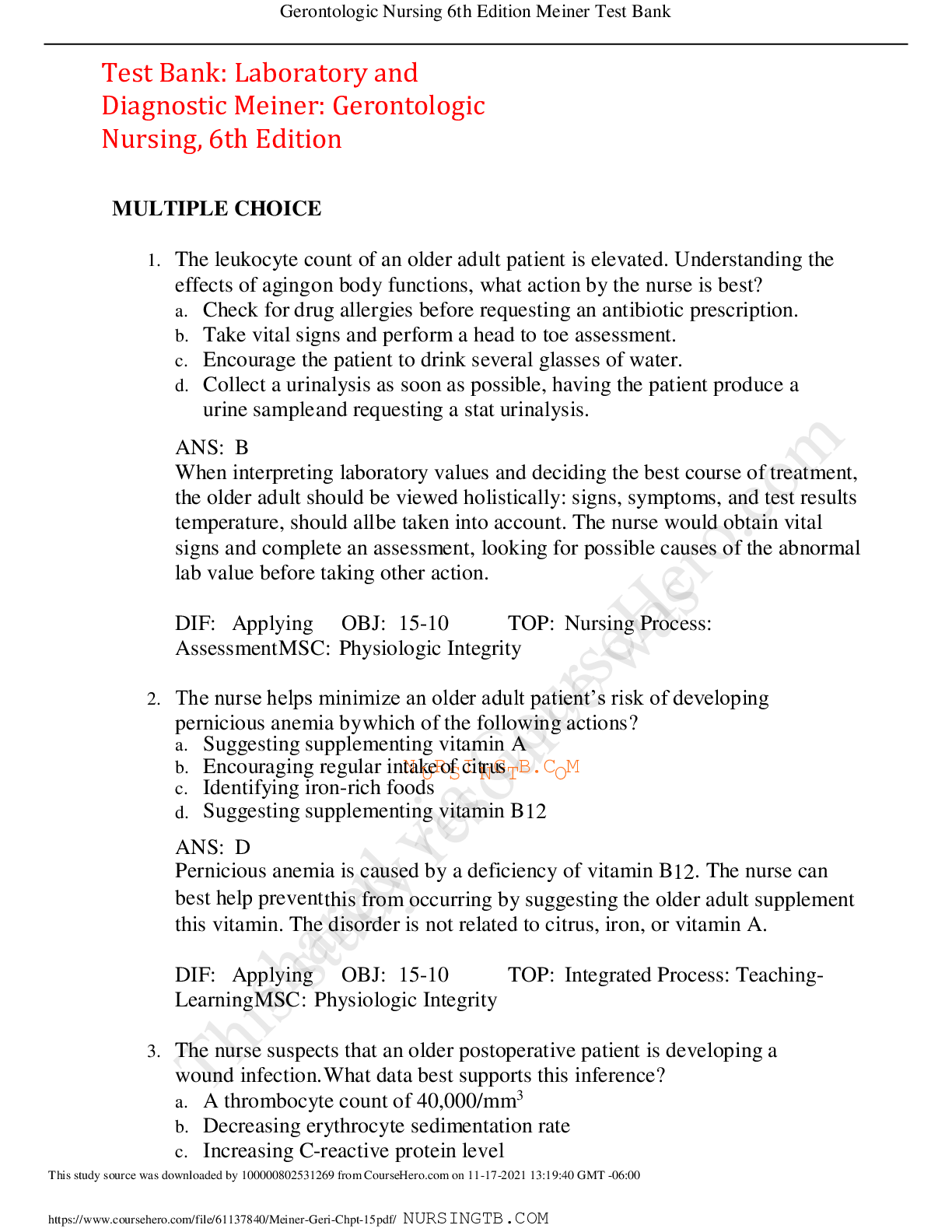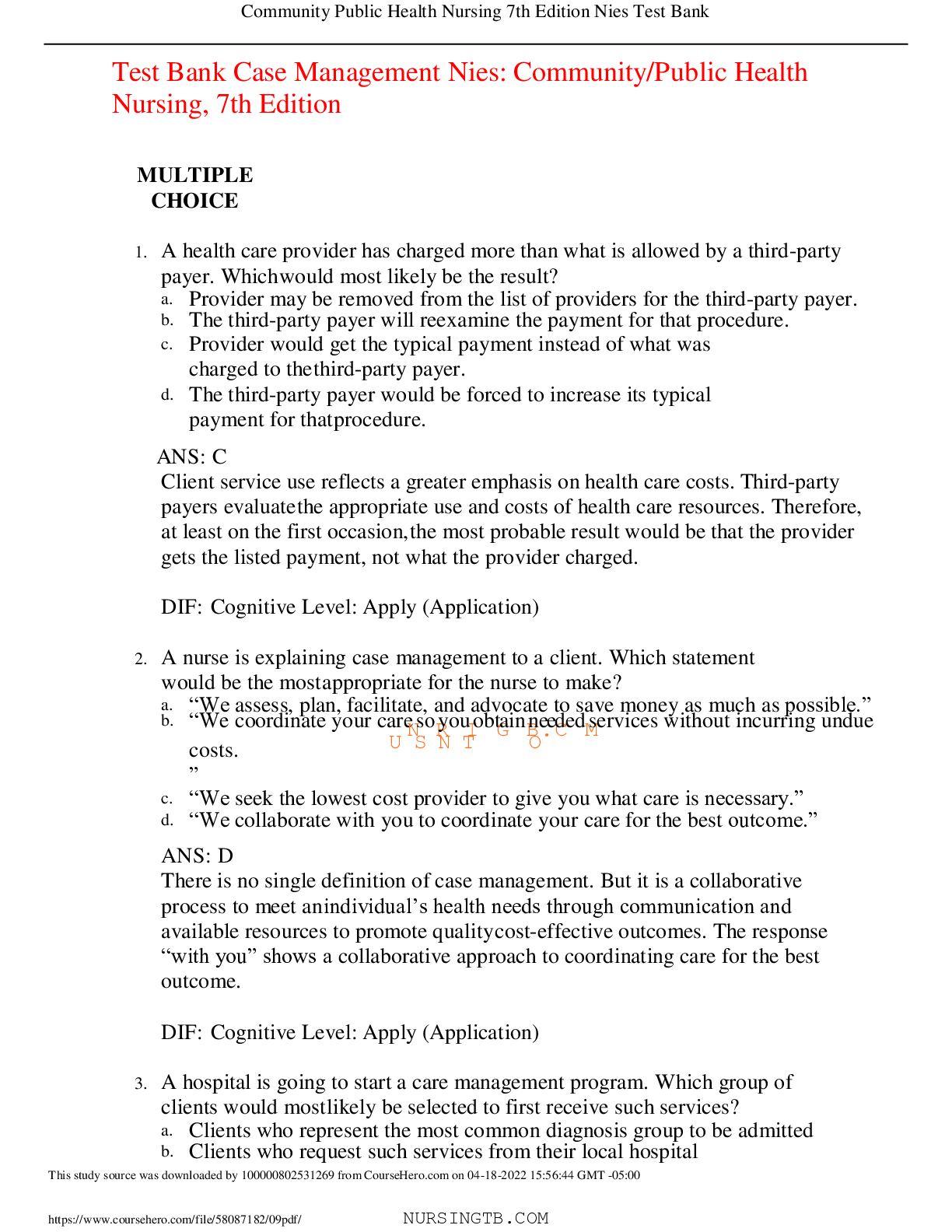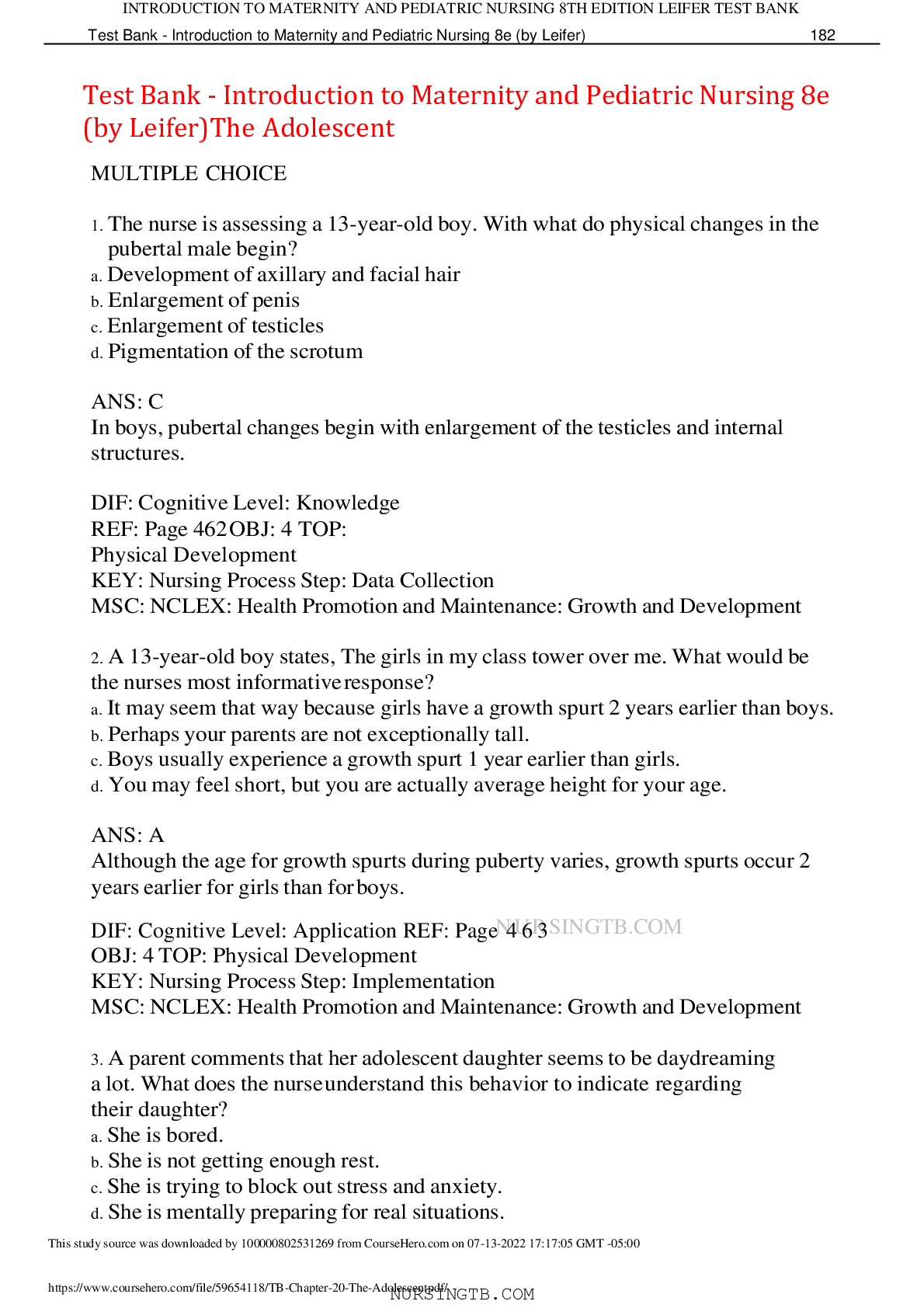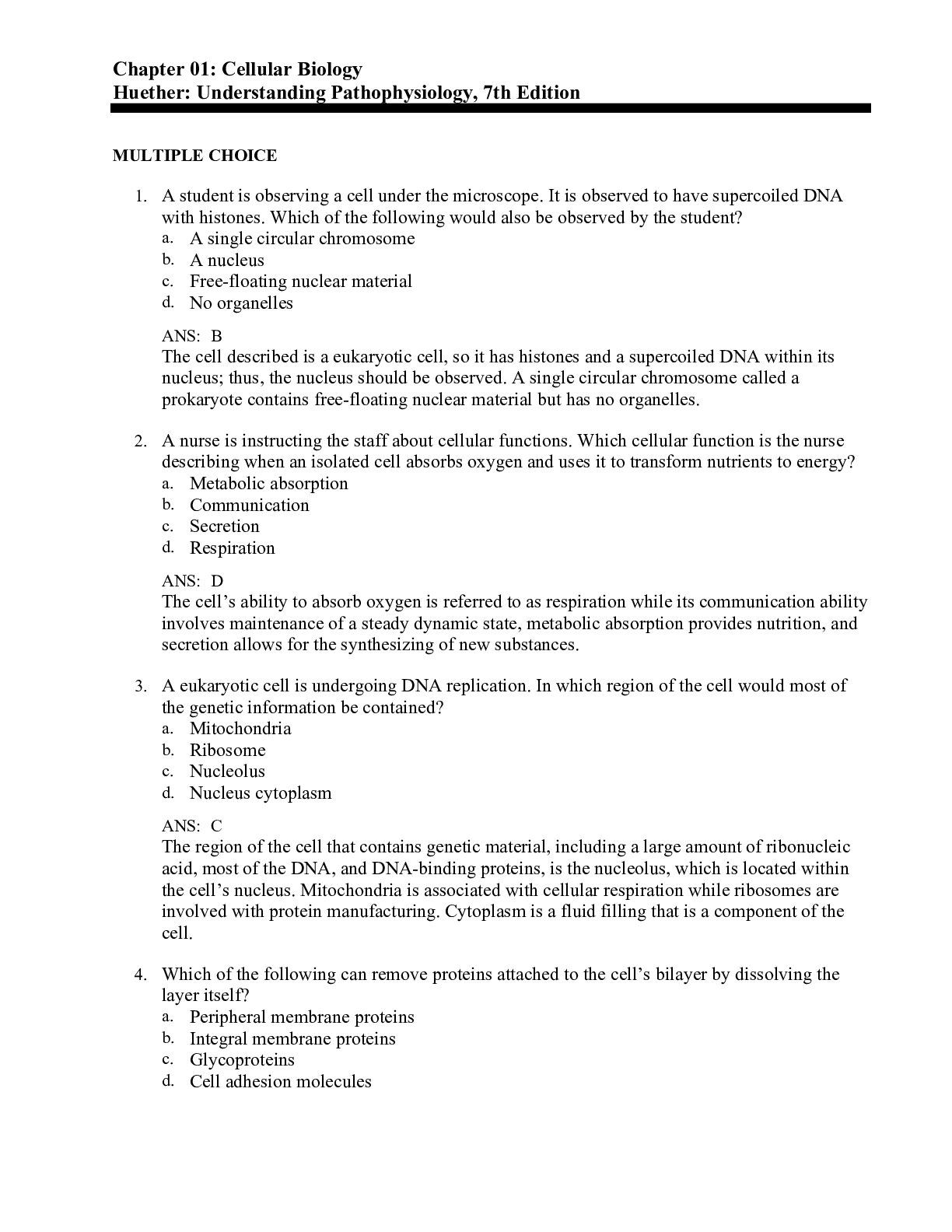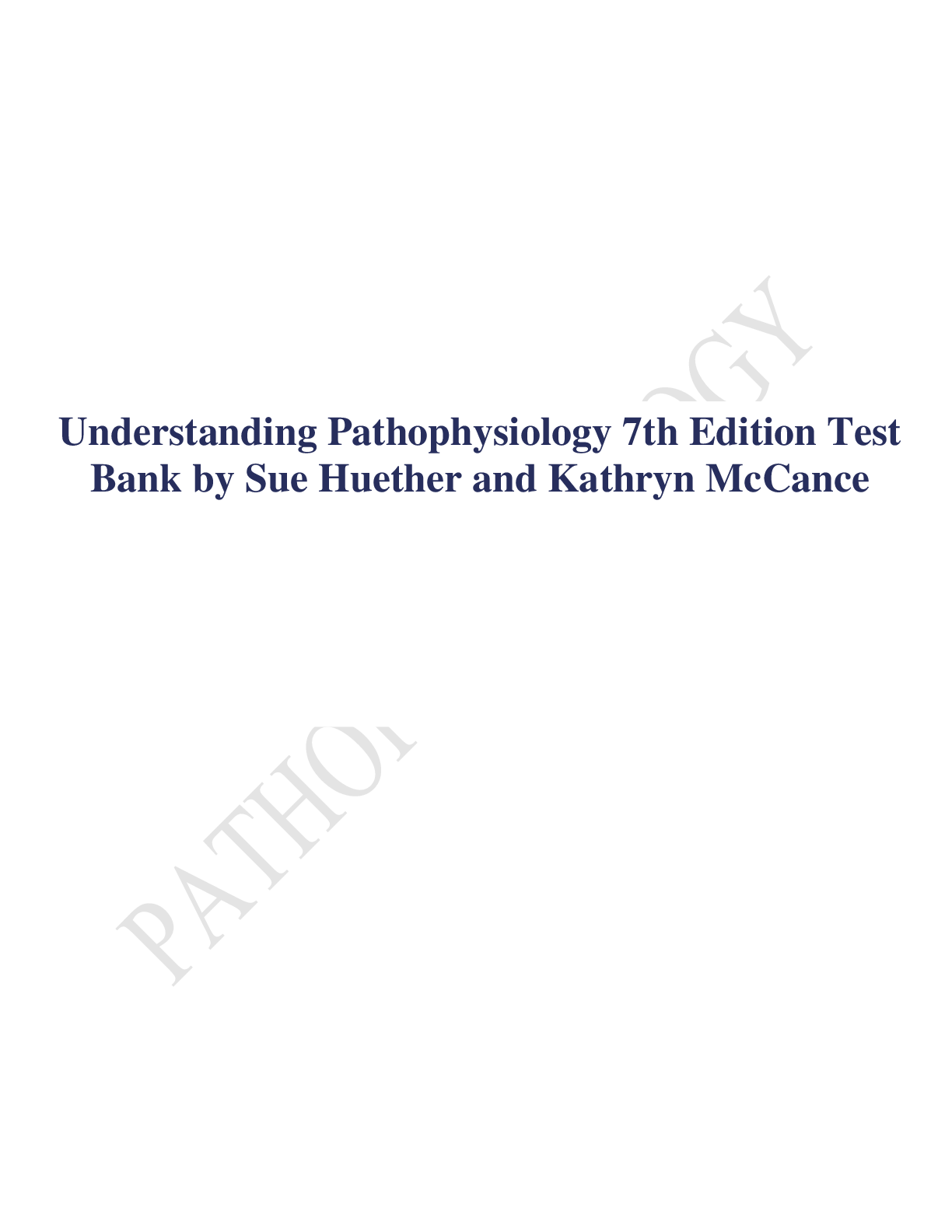*NURSING > TEST BANK > Test Bank: Adaptive Immunity Huether: Understanding Pathophysiology, 7th Edition,100% CORRECT (All)
Test Bank: Adaptive Immunity Huether: Understanding Pathophysiology, 7th Edition,100% CORRECT
Document Content and Description Below
Test Bank: Adaptive Immunity Huether: Understanding Pathophysiology, 7th Edition MULTIPLE CHOICE 1. Which of the following is responsible for initiating clonal selection? a. T cells b. B cel... ls c. Antigens d. Lymphocytes ANS: C The lymphocytes remain dormant until an antigen initiates clonal selection. T cells do not initiate clonal selection. B cells are antibodies. Lymphocytes are released into the circulation as immature cells that react with antigens. 2. Which patient will develop active immunity? A patient who: a. has natural exposure to an antigen or receives an immunization. b. receives preformed antibodies or T cells from a donor. c. has T cells that become B cells. d. receives immunoglobulin. ANS: A Active immunity occurs either after natural exposure to an antigen or after immunization, not with preformed antibodies or the transformation of T cells into B cells or as a result of receiving immunoglobulin. NURSINGKING.COM 3. An experiment is designed to determine specific cell types involved in cell-mediated immune response. The experimenter is interested in finding cells that attack cells that have specific antigens. Which cells should be isolated? a. Lymphokine-producing cells b. T-cytotoxic cells c. Helper T cells d. Macrophages ANS: B Cell-mediated immunity is driven by T-cytotoxic (Tc) cells that attack antigens directly and destroy cells that bear foreign antigens. Lymphokine-producing cells, helper T cells, and macrophages do not attack antigens directly and destroy cells that bear foreign antigens. 4. A 6-year-old female is diagnosed with a bacterial infection of the respiratory system. Which of the following will most likely try to fight the antigen? a. Antibodies b. Cytotoxic T cells c. Self-antigens d. Helper T cells ANS: A Antibodies are produced by plasma cells that mature from lymphocytes, called B lymphocytes (B cells), in response to an antigen. Cytotoxic T cells do not respond to antigens. Self-antigens do not respond to antigens. Helper T cells do not respond to antigens. 5. Which statement indicates a correct understanding of antibodies? The most abundant class of antibody in the serum is: a. IgG. b. IgM. c. IgA. d. IgE. ANS: A IgG is the most abundant class of immunoglobulins, constituting 80%–85% of the immunoglobulins in the blood. 6. The predominant antibody of a typical primary immune response is: a. IgG. b. IgM. c. IgA. d. IgE. ANS: B IgM is the largest immunoglobulin and is the first antibody produced during the initial, or primary, response to antigen. 7. An immunology nurse is caring for a patient. While planning care, which principle will the nurse remember? The primary role of IgA1 is to prevent infections in the: a. blood. b. kidneys. c. lungs. d. mucous membranes. ANS: A NURSINGKING.COM IgA1 is found predominantly in the blood. 8. A 23-year-old pregnant female visits her primary care provider for her final prenatal checkup. The primary care provider determines that the fetus has developed an infection in utero. Which of the following would be increased in the fetus at birth? a. IgG b. IgA c. IgM d. IgD ANS: C IgM is synthesized early in neonatal life, and its synthesis may be increased as a response to infection in utero. 9. Which portion of the antibody is responsible for the biologic functions of antibodies? a. Heavy chain b. Variable region c. Fc portion d. Epitope ANS: C The Fc portion is responsible for most of the functions of antibodies. None of the remaining options are responsible for most of the functions of antibodies. 10. A 25-year-old female has sexual relations with her boyfriend. Later she is told that the boyfriend is infected with Neisseria gonorrhoeae. Testing reveals that she does not have the disease. How is it possible that she did not contract the disease? a. Antibodies covered sites of attachment. b. She was vaccinated against it. c. Platelets provided protection. d. IgE was released. ANS: A Some bacteria, such as N. gonorrhoeae that causes gonorrhea, must attach to specific sites on urogenital epithelial cells. Antibodies may protect the host by covering sites on the microorganism that are needed for attachment, thereby preventing infection. Neither a vaccination, the protection of platelets, nor the release of IgE was relevant to the client’s ability to avoid contracting this disease. 11. A patient has a disease state that results from the secretion of toxins by bacteria. Which medical diagnosis will the nurse see documented on the chart? a. Malaria b. Tetanus c. Smallpox d. Hepatitis ANS: B NURSINGKING.COM Some bacteria secrete toxins that harm individuals. For instance, specific bacterial toxins cause the symptoms of tetanus or diphtheria. This is not true of malaria, smallpox, or hepatitis. 12. A 10-year-old male is stung by a bee while playing in the yard. He experiences a severe allergic reaction and has to go to the ER. The nurse providing care realizes this reaction is the result of: a. toxoids. b. IgA. c. IgE. d. IgM. ANS: C IgE is normally at low concentrations in the circulation. It has very specialized functions as a mediator of many common allergic responses. Neither toxoids, IgA, nor IgM is the mediator of common allergic response. 13. A patient has done research on monoclonal antibodies on the Internet. Which statement indicates a correct understanding? Pure monoclonal antibodies are produced by: a. T lymphocytes. b. bone marrow. c. laboratories. d. fetuses. ANS: C Monoclonal antibodies are produced in the laboratory from one B cell that has been cloned; thus, the entire antibody is of the same class, specificity, and function. Pure monoclonal antibodies are not produced by T lymphocytes, bone marrow, or fetuses. 14. Which of the following statements indicates more teaching is needed regarding secondary lymph organs? is/are a secondary lymphoid organ. a. The spleen b. Peyer patches c. Adenoids d. The liver ANS: D The liver is not a secondary lymph organ. The spleen, Peyer patches, and adenoids are secondary lymphoid organs. 15. A 20-year-old female is applying for nursing school and is required to be tested for immunity against several illnesses. Testing that looks at which of the following would be the best to determine immunity? a. Culture and sensitivity b. Agglutination c. Precipitation d. Titer ANS: D The amount of antibody in a serum sample is referred to as the titer; a higher titer indicates more antibodies. Culture determines the type of organism that causes an infection, and sensitivity identifies the antibNodUyRiSt iIs NseGnKsiItivNeGto..CTOheMterms agglutination and precipitation are not used to identify a test to determine immunity. 16. A macrophage was isolated and analyzed for major histocompatibility complex. Which of the following would be expected? a. MHC I only b. MHC II only c. MHC I and II d. Neither MHC I nor MHC II ANS: C MHC I and II would be expected. 17. A 5-month-old child is admitted to the hospital with recurring respiratory infections. A possible cause of this condition is: a. hypergammaglobulinemia. b. increased maternal IgG. c. immune insufficiency. d. decreased maternal antibody breakdown, resulting in hyposensitivity. ANS: C Normal human infants are immunologically immature when born, with deficiencies in antibody production, phagocytic activity, and complement activity, especially components of alternative pathways. They do not possess hypergammaglobulinemia. Possessing increased maternal IgG would not lead to recurring infections. The recurrent infections are due to decreased immunity, not maternal antibody breakdown. MULTIPLE RESPONSE 1. While planning care for an elderly patient, the nurse remembers that increased age is associated with: (Select all that apply.) a. increased T-cell function. b. decreased immune function. c. increased production of antibodies. d. decreased numbers of circulating immune complexes. e. decreased ability to fight infection. ANS: B, D, E Increased age is associated with diminished T-cell function, decreased immune function, diminished production of antibody responses, decreased circulating immune complexes, and decreased ability to fight infection. 2. When a patient asks about secondary lymph organs, how should the nurse respond? Secondary lymph organs include: (Select all that apply.) a. the spleen. b. Peyer patches. c. adenoids. d. the liver. e. bone marrow. f. the appendix. ANS: A, B, C, F NURSINGKING.COM The secondary lymphoid organs include the spleen, lymph nodes, adenoids, tonsils, Peyer patches (intestines), and appendix. The liver and bone marrow are not secondary lymph organs. 3. Direct effects of antibodies include: (Select all that apply.) a. neutralization. b. agglutination. c. precipitation. d. phagocytosis. e. division. ANS: A, B, C Directly, antibodies can affect infectious agents or their toxic products by neutralization (inactivating or blocking the binding of antigen to receptors), agglutination (clumping insoluble particles that are in suspension), or precipitation (making a soluble antigen into an insoluble precipitate). Indirectly, antibodies activate components of innate resistance, including complement and phagocytes. Antibodies are generally a mixed population of classes, specificities, and capacity to provide the functions listed above. [Show More]
Last updated: 1 year ago
Preview 1 out of 10 pages

Reviews( 0 )
Document information
Connected school, study & course
About the document
Uploaded On
Nov 06, 2021
Number of pages
10
Written in
Additional information
This document has been written for:
Uploaded
Nov 06, 2021
Downloads
0
Views
38










